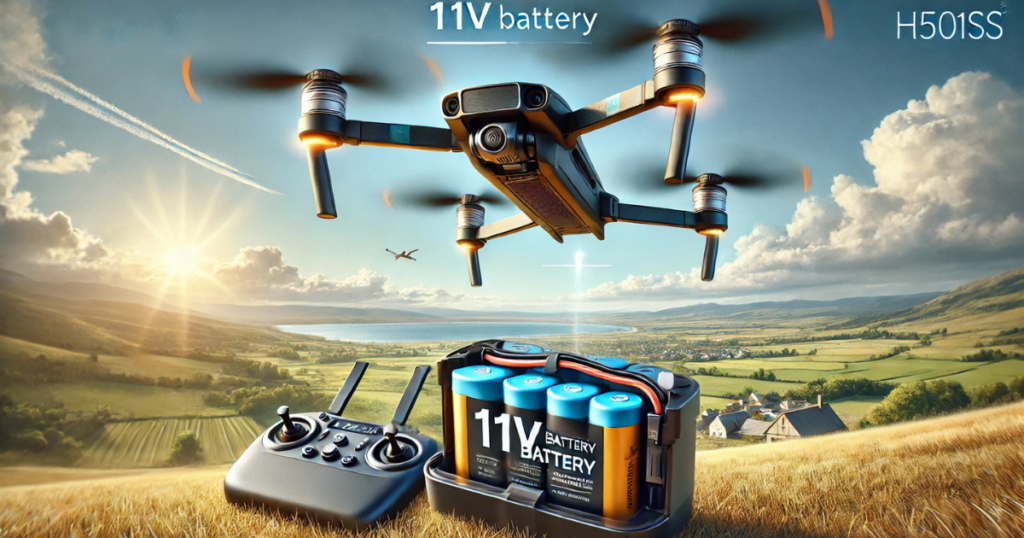The Hubsan H501SS is a popular drone for both beginners and intermediate enthusiasts, offering an excellent balance of affordability and performance. One key aspect that affects its overall performance is the battery. If you’re wondering, Can you use an 11V battery in a Hubsan H501SS? This guide explores the potential benefits and risks of switching to an 11V battery for your drone.
Understanding the Hubsan H501SS Battery Requirements
Before addressing whether you can use an 11V battery, it’s essential to understand the battery specifications for the Hubsan H501SS and why battery compatibility matters.
Original Battery Specifications
The Hubsan H501SS typically uses a 7.4V, 2700mAh Li-ion battery. This battery offers a good balance between flight time and weight, allowing for around 20 minutes of flight on a full charge. The voltage is selected to meet the power needs of the drone’s motors and electronics.
Why Battery Compatibility Matters
Choosing the right battery ensures the drone performs optimally and doesn’t face issues like overheating or unstable flight. Incompatible batteries can negatively affect your drone, causing malfunctions, crashes, or shorter battery life.
Risks of Using Incompatible Batteries
A battery with too high or low of a voltage can harm the drone. Using a higher voltage could damage the electronics, while using a lower voltage may not provide enough power for stable flight, potentially leading to a crash.
Can You Use an 11V Battery in a Hubsan H501SS?
Now, let’s explore whether you can safely use an 11V battery in the Hubsan H501SS.
Technical Feasibility
“You can technically use an 11V battery in your Hubsan H501SS, but several factors require consideration. The drone is designed for a 7.4V battery, so switching to a higher voltage, such as 11V, may cause changes in flight dynamics. The higher voltage could lead to faster motor speeds, but it could also cause extra strain on the drone’s components. Can you use an 11V battery in a Hubsan H501SS? While it’s possible, the added power may affect the drone’s overall performance and longevity.
Voltage and Current Considerations
Voltage plays a crucial role in powering the drone. An 11V battery delivers more power, which could increase speed and flight time. However, the drone’s motors and controllers may not be able to handle this additional power over time. Excess voltage could lead to overheating or damage to key parts like the ESCs and flight controller.
Also Read: Ecryptobit
Is It Safe to Use an 11V Battery in the Hubsan H501SS?
While it’s possible to use an 11V battery, it’s not the safest option. Higher voltage can stress the drone’s internal components, possibly causing overheating and reducing the lifespan of the motors and battery. The electronics are optimized for 7.4V, so using 11V may result in failure or damage.
Benefits of Using an 11V Battery in a Hubsan H501SS
Some users may still consider using an 11V battery to gain certain benefits.
Improved Flight Time
One of the most obvious benefits of an 11V battery is potentially longer flight time. Higher voltage batteries often provide more power, allowing the drone to fly for longer periods before requiring a recharge.
Enhanced Power and Stability
A higher voltage battery can improve power delivery, leading to smoother and more responsive flight. The Hubsan H501SS might be able to handle gusty winds or higher altitudes more effectively with the additional power, which could enhance its overall stability during challenging flights.
Potential for Better Performance in Harsh Conditions
An 11V battery can provide a more consistent power supply, which may be beneficial in tough weather conditions. When flying in cold temperatures or strong winds, the added power from an 11V battery may help the drone maintain stable flight and better performance.
Risks of Using an 11V Battery in a Hubsan H501SS
While there are benefits, users should be cautious of the risks when using an 11V battery.
Potential Damage to Electronics
Using an 11V battery may overburden the drone’s internal components, including the ESCs and flight controller. These parts are designed for 7.4V and could be damaged by the excess voltage over time, leading to costly repairs.
Reduced Lifespan of Drone Components
Constant exposure to higher voltage will likely shorten the lifespan of the drone’s motors and other components. While you might experience improved performance initially, the long-term effects may include a greater need for maintenance and more frequent replacement of parts.
Safety Concerns
An 11V battery introduces additional risks, such as overheating, potential fires, or battery failure. These issues can be particularly dangerous if the drone crashes in a remote area where immediate help isn’t available.
Conclusion
While Can You Use an 11V Battery in a Hubsan H501SS to offer some performance improvements, the risks often outweigh the benefits. The Hubsan H501SS is built for a 7.4V battery, and straying from these specifications can cause harm to the drone’s internal components. If you’re not experienced with drone modifications, it’s safer to stick with the recommended battery.
If you decide to experiment with an 11V battery, make sure to monitor the drone’s temperature regularly. Check the motor and battery conditions before and after each flight. Never push the drone to its limits, as it can cause unnecessary strain on the components.
In the end, the safest and most reliable choice for your Hubsan H501SS is to use the 7.4V battery. Although Can You Use an 11V Battery in a Hubsan H501SS might provide a boost in performance, it comes with significant risks. For those who are not looking to make drastic modifications, sticking with the recommended battery ensures your drone’s longevity and consistent performance.

